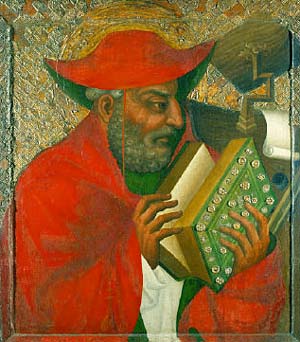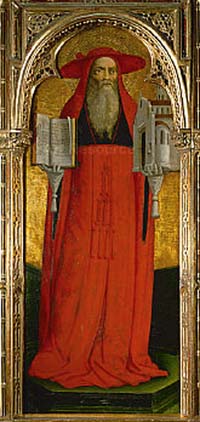 |
The Saint of the Day
St. Jerome – September 30
Prof. Plinio Corrêa de Oliveira
Biographical selection:
St. Jerome, Confessor and Doctor of the Church (c. 341-420) is considered the Church’s greatest Doctor of Scriptures.

St. Jerome, Confessor and Doctor of the Church
Master Theoderich, 14th century
|
He conferred this praise upon St. Augustine: “As I have done, you applied all your energy to make the enemies of the Church your personal enemies.” This eulogy is consistent with the counsel of St. Augustine: “You must hate the evil, but love the one who errs.”
Regarding St. Jerome the Roman Breviary says: “He pummeled the heretics with his most harsh writings.”
Comments of Prof. Plinio:
In the Catholic Church, St. Jerome is the representative par excellence of the polemical spirit, and in this sense he is a symbol against progressivist ecumenical dialogue. His writings are so straightforward, energetic, and intransigent that some people imagine that a saint could not write as he did. Almost everyone of his time trembled before him.
Once St. Augustine, with whom he had an ongoing correspondence, amiably told him that with half the energy St. Jerome used in one of his letters, he would already be convinced of his argument. I also remember that once I read that a pious lady sent St. Jerome a gift: some young doves and a basket of cherries. He wrote back asking her what she was thinking when she sent those delicate things to him. He was suspicious that she might want to corrupt the austerity of his penitent life. He immediately gave the presents to the poor.
One of my first encounters with Progressivism was with the reformist liturgical mentality that was being accepted by many monks in the Benedictine Monastery in Sao Paulo. I was talking with the Abbot and he told me that some works of St. Jerome were being read in the refectory of the monastery during the midday meal. He commented that the monks had become furious over the readings. In my naiveté, I thought that their hatred was directed toward the heretics St. Jerome combated, but I soon realized that I was wrong. Their hatred was against St. Jerome himself, because they had sympathy for the heretics.
The combativity of St. Jerome was an expression of his consuming zeal for the House of God. This kind of militancy is one of the most legitimate and saintly expressions of that zeal. Since his energy was inspired by love for God and not by personal resentments, it was a very holy thing. If force is exerted because of personal resentments, it is a completely different thing.
That saintly militancy made him a living sword of God. I know of no higher praise than to say that a man is the living sword of God, cutting, piercing, wounding, and destroying His enemies. St. Jerome represents the pinnacle of the polemic spirit, and as such he is the Patron Saint of the counter-revolutionary fight.
His eulogy of St. Augustine about how he made the Church’s enemies his personal enemies is remarkable. It is one saint praising another one, and for this reason it can be said that the eulogy reflects the sanctity of the Church. The selection points out well that this aspect harmonizes perfectly with another apparently contrary one that can be seen in other words of St. Augustine: “We must hate evil, but love those who err.”

St. Jerome's militancy made him a living sword of God
Antonio Vivarini
|
Today it is important that we have a clear understanding of what it means to love those who err. It is a liberal and ecumenical simplification to say that if one vigorously attacks those who err, he is harming these persons or showing a lack of charity. There are three reasons why this is not the case:
First, when a person is in grave danger of falling into an abyss, the right thing to do is to shout at him and say, “Be careful, you are at the edge of the cliff and if you fall, you will crack your head and die.” It would not be sensible to speak mildly, saying: “Hello there, I am standing in a much better place than you. Why don’t you come join me?”
This would be a foolish way to keep the man from falling into the abyss. The right way to rescue a man from danger is not to show the positive side of your position, but to expose the danger of his position and the imprudence of remaining in it.
Which one of you, seeing a man imprudently playing with a loaded gun and having his finger on the trigger, would gently suggest he play chess with you instead? It is a foolish attitude. The right thing is to address him sternly: “Look, stop playing with that gun or you might hurt yourself or me.” A man who is tempted to do something wrong needs to be addressed with words that inspire fear.
This is true above all when we deal with Catholic doctrine. Men are more easily moved by fear of bad consequences they can experience than a possible good they may enjoy. They are more easily moved by fear of Hell than by love of Heaven. Therefore, in order to convert a man, it is more charitable and expedient for us to first point out his error and its bad consequences, and then speak about the beauty and goodness of the truth. St. Jerome was a model of this way of acting.
I know that some rare souls may be touched by sweetness rather than combativity, but this is not the rule. It is the exception to the rule. God gives His Church saints who have special charismas to attract with amiability, such as St. Francis of Sales, who drew souls by his sweetness. However, the rule is to attack the evil to convert the person, as St. Jerome did.
Second, another simplification that the liberal and ecumenical spirit does not consider is that when we debate a heretic, a Protestant pastor for example, our primary goal is not to convert him, but to confirm in their Faith the Catholics who are following the debate and help them to not be contaminated by the Protestant errors. To this end, it is extremely advantageous to defeat the heretic.
The secondary goal of the debate is to convert the Protestants who are also following the debate and are not as obstinate in error as the pastor. The third and last aim is the conversion of the Protestant pastor, which should also be seriously considered. This is the correct hierarchy of aims in a debate of a Catholic with a Protestant. The progressivists simplify the topic enormously by saying that it is just a debate between A and B, and that the most efficient way to convert B is to smile and make concessions. It is not like that. By ignoring the two most important goals of the debate, a trap is set to lead people into a more progressivist and ecumenical mentality.
Third, Our Lord, the divine model of sanctity, did not act with conciliation when he debated with the Pharisees. Instead, he called them as a generation of vipers, sons of Satan, whited sepulchers, etc. Also, when He came upon the money-changers in the Temple, He became indignant and used a whip to physically drive them out. That is, He used not only energy in the polemic against evil people, but He also used physical violence to punish the profaners.
The militant and polemic spirit of the great St. Jerome gives us the opportunity to see how Progressivism and the ecumenical spirit are sabotaging Catholic militancy everywhere. Today almost no one hears this Catholic doctrine taught in its entirety.
The progressivist Church avoids this teaching because it wants to push its agenda of ecumenism tending toward a spurious Pan-Religion.
We should certainly ask St. Jerome to help us in our counter-revolutionary polemics, but we should also and primarily ask him to help us destroy this liberal mentality that opens the door for the evil that is assaulting and taking over the entire Church.


  | | Prof. Plinio Corrêa de Oliveira | |
The Saint of the Day features highlights from the lives of saints based on comments made by the late Prof. Plinio Corrêa de Oliveira. Following the example of St. John Bosco who used to make similar talks for the boys of his College, each evening it was Prof. Plinio’s custom to make a short commentary on the lives of the next day’s saint in a meeting for youth in order to encourage them in the practice of virtue and love for the Catholic Church. TIA thought that its readers could profit from these valuable commentaries.
The texts of both the biographical data and the comments come from personal notes taken by Atila S. Guimarães from 1964 to 1995. Given the fact that the source is a personal notebook, it is possible that at times the biographic notes transcribed here will not rigorously follow the original text read by Prof. Plinio. The commentaries have also been adapted and translated for TIA’s site.
|
Saint of the Day | Home | Books | CDs | Search | Contact Us | Donate

© 2002- Tradition in Action, Inc. All Rights Reserved
|
 |

|